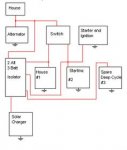redjmp
Chief Petty Officer
- Joined
- Mar 16, 2005
- Messages
- 536
Here is a proposed system using 2 or 3 batteries.
Please critique it for flaws.
I have all the components already.
I think it is bullet proof in that switching to off while charging should not blow the charging system.
Starting is always from the starting battery no matter which way the switch is. Autobilge pump is tied into this circuit and is always energised.
House battery can be added to start.
Either or both batteries can be used for house.
Either or both batteries are always charging when engine is running even when switch set to off.
The weak link is the switch as far as I can tell...
Even though switching to off should not blow anything, it will need constant switching.
Setting to 1 will mean the house battery is connected to the house and charging/draining while the starting battery isn't charging.
Setting to 2 mean the house battery isn't charging or feeding the house because the starting battery now is.
Setting to both means both batteries are draining and charging but will draw them down when not running.
Setting to off means both are charging through the isolator but the house is only being fed by the alternator. Turn off the engine and the house goes dead.
Hopefully this won't cause anything to blow OR WILL IT?
I would like to have this type of system automated so that I don't have to worry about flipping the switch everytime I want to charge the starting battery....
I am also curious as to whether there is a way to compensate for the 0.7 volt drop across the isolator?
Someone suggested installing a 1 watt diode inline with the ground of the regulator to raise its output threshold by the same 0.7 volts lost at the isolator.
However I need to get a new alternator and can only find ones that only have 3 wires and no ground wire at the regulator for a reasonable price.
So I am curious, if I run the sensor wire from the regulator straight to the battery terminal, will the regulator compensate for the voltage drop across the isolator diodes without having to install the extra diode?
Thanks for taking the time to have a look.
Please critique it for flaws.
I have all the components already.
I think it is bullet proof in that switching to off while charging should not blow the charging system.
Starting is always from the starting battery no matter which way the switch is. Autobilge pump is tied into this circuit and is always energised.
House battery can be added to start.
Either or both batteries can be used for house.
Either or both batteries are always charging when engine is running even when switch set to off.
The weak link is the switch as far as I can tell...
Even though switching to off should not blow anything, it will need constant switching.
Setting to 1 will mean the house battery is connected to the house and charging/draining while the starting battery isn't charging.
Setting to 2 mean the house battery isn't charging or feeding the house because the starting battery now is.
Setting to both means both batteries are draining and charging but will draw them down when not running.
Setting to off means both are charging through the isolator but the house is only being fed by the alternator. Turn off the engine and the house goes dead.
Hopefully this won't cause anything to blow OR WILL IT?
I would like to have this type of system automated so that I don't have to worry about flipping the switch everytime I want to charge the starting battery....
I am also curious as to whether there is a way to compensate for the 0.7 volt drop across the isolator?
Someone suggested installing a 1 watt diode inline with the ground of the regulator to raise its output threshold by the same 0.7 volts lost at the isolator.
However I need to get a new alternator and can only find ones that only have 3 wires and no ground wire at the regulator for a reasonable price.
So I am curious, if I run the sensor wire from the regulator straight to the battery terminal, will the regulator compensate for the voltage drop across the isolator diodes without having to install the extra diode?
Thanks for taking the time to have a look.




















